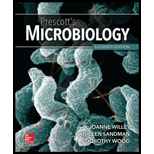
Prescott's Microbiology
11th Edition
ISBN: 9781260409062
Author: WILLEY, Joanne
Publisher: MCGRAW-HILL HIGHER EDUCATION
expand_more
expand_more
format_list_bulleted
Concept explainers
Question
Chapter 20.1, Problem 1CC
Summary Introduction
Archaea are categorized into six groups based on morphological and physiological differences. However, Bergey’s manual of systemic bacteriology, a taxonomic organization divides archaea into two phyla such as Crenarchaeota and Euryarchaeota. However, the third phylum such as Thaumarchaeota was recently documented. All methanogenic microorganisms that belong to Euryarchaeota are known as methanogens. There are three types of carbon fixation that have been characterized in archaea. This includes the reductive acetyl-CoA pathway, dicarboxylate/4-hydroxybutyrate cycle (DC/HB), and the 3-hydroxypropionate/4-hydroxybutyrate cycle (HP/HB).
Expert Solution & Answer
Want to see the full answer?
Check out a sample textbook solution
Students have asked these similar questions
What symbolic and cultural behaviors are evident in the archaeological record and associated with Neandertals and anatomically modern humans in Europe beginning around 35,000 yBP (during the Upper Paleolithic)?
Describe three cranial and postcranial features of Neanderthals skeletons that are likely adaptation to the cold climates of Upper Pleistocene Europe and explain how they are adaptations to a cold climate.
Biology Question
Chapter 20 Solutions
Prescott's Microbiology
Ch. 20.1 - MICRO INQUIRY Given that the DC/HB pathway uses...Ch. 20.1 - Prob. 2MICh. 20.1 - Prob. 1CCCh. 20.1 - Why do methanogens use the reductive acetyl-CoA...Ch. 20.1 - Prob. 3CCCh. 20.1 - Compare the ATP and NADH yield of each of the...Ch. 20.2 - MICRO INQUIRY Identify the potential electron...Ch. 20.2 - Retrieve, Infer, Apply What are thermoacidophiles...Ch. 20.2 - Prob. 2CCCh. 20.2 - Compare the carbon and sulfur metabolism of...
Ch. 20.2 - Prob. 4CCCh. 20.2 - Prob. 5CCCh. 20.3 - MICRO INQUIRY What are the mechanisms by which...Ch. 20.3 - Retrieve, Infer, Apply Why are the growth yields...Ch. 20.3 - Prob. 2CCCh. 20.3 - What is the ecological and practical importance of...Ch. 20.3 - Where are extreme halophiles found, and what is...Ch. 20.3 - What is the difference between sensory rhodopsin...Ch. 20.3 - How is Thermoplasma able to live in acidic, very...Ch. 20.3 - In what way are members of the genus Archaeoglobus...Ch. 20 - Prob. 1RCCh. 20 - Prob. 2RCCh. 20 - Prob. 3RCCh. 20 - Prob. 4RCCh. 20 - Prob. 5RCCh. 20 - Prob. 6RCCh. 20 - Prob. 7RCCh. 20 - Some believe that archaea should not be separate...Ch. 20 - Prob. 2ALCh. 20 - Prob. 3ALCh. 20 - Prob. 4ALCh. 20 - Prob. 5ALCh. 20 - Prob. 6ALCh. 20 - Prob. 7AL
Knowledge Booster
Learn more about
Need a deep-dive on the concept behind this application? Look no further. Learn more about this topic, biology and related others by exploring similar questions and additional content below.Similar questions
- ✓ Details Draw a protein that is embedded in a membrane (a transmembrane protein), label the lipid bilayer and the protein. Identify the areas of the lipid bilayer that are hydrophobic and hydrophilic. Draw a membrane with two transporters: a proton pump transporter that uses ATP to generate a proton gradient, and a second transporter that moves glucose by secondary active transport (cartoon-like is ok). It will be important to show protons moving in the correct direction, and that the transporter that is powered by secondary active transport is logically related to the proton pump.arrow_forwarddrawing chemical structure of ATP. please draw in and label whats asked. Thank you.arrow_forwardOutline the negative feedback loop that allows us to maintain a healthy water concentration in our blood. You may use diagram if you wisharrow_forward
- Give examples of fat soluble and non-fat soluble hormonesarrow_forwardJust click view full document and register so you can see the whole document. how do i access this. following from the previous question; https://www.bartleby.com/questions-and-answers/hi-hi-with-this-unit-assessment-psy4406-tp4-report-assessment-material-case-stydu-ms-alecia-moore.-o/5e09906a-5101-4297-a8f7-49449b0bb5a7. on Google this image comes up and i have signed/ payed for the service and unable to access the full document. are you able to copy and past to this response. please see the screenshot from google page. unfortunality its not allowing me attch the image can you please show me the mathmetic calculation/ workout for the reult sectionarrow_forwardIn tabular form, differentiate between reversible and irreversible cell injury.arrow_forward
- 1.)What cross will result in half homozygous dominant offspring and half heterozygous offspring? 2.) What cross will result in all heterozygous offspring?arrow_forward1.Steroids like testosterone and estrogen are nonpolar and large (~18 carbons). Steroids diffuse through membranes without transporters. Compare and contrast the remaining substances and circle the three substances that can diffuse through a membrane the fastest, without a transporter. Put a square around the other substance that can also diffuse through a membrane (1000x slower but also without a transporter). Molecule Steroid H+ CO₂ Glucose (C6H12O6) H₂O Na+ N₂ Size (Small/Big) Big Nonpolar/Polar/ Nonpolar lonizedarrow_forwardwhat are the answer from the bookarrow_forward
arrow_back_ios
SEE MORE QUESTIONS
arrow_forward_ios
Recommended textbooks for you
 Biology 2eBiologyISBN:9781947172517Author:Matthew Douglas, Jung Choi, Mary Ann ClarkPublisher:OpenStax
Biology 2eBiologyISBN:9781947172517Author:Matthew Douglas, Jung Choi, Mary Ann ClarkPublisher:OpenStax Biology: The Dynamic Science (MindTap Course List)BiologyISBN:9781305389892Author:Peter J. Russell, Paul E. Hertz, Beverly McMillanPublisher:Cengage Learning
Biology: The Dynamic Science (MindTap Course List)BiologyISBN:9781305389892Author:Peter J. Russell, Paul E. Hertz, Beverly McMillanPublisher:Cengage Learning Biology (MindTap Course List)BiologyISBN:9781337392938Author:Eldra Solomon, Charles Martin, Diana W. Martin, Linda R. BergPublisher:Cengage Learning
Biology (MindTap Course List)BiologyISBN:9781337392938Author:Eldra Solomon, Charles Martin, Diana W. Martin, Linda R. BergPublisher:Cengage Learning


Biology 2e
Biology
ISBN:9781947172517
Author:Matthew Douglas, Jung Choi, Mary Ann Clark
Publisher:OpenStax


Biology: The Dynamic Science (MindTap Course List)
Biology
ISBN:9781305389892
Author:Peter J. Russell, Paul E. Hertz, Beverly McMillan
Publisher:Cengage Learning


Biology (MindTap Course List)
Biology
ISBN:9781337392938
Author:Eldra Solomon, Charles Martin, Diana W. Martin, Linda R. Berg
Publisher:Cengage Learning